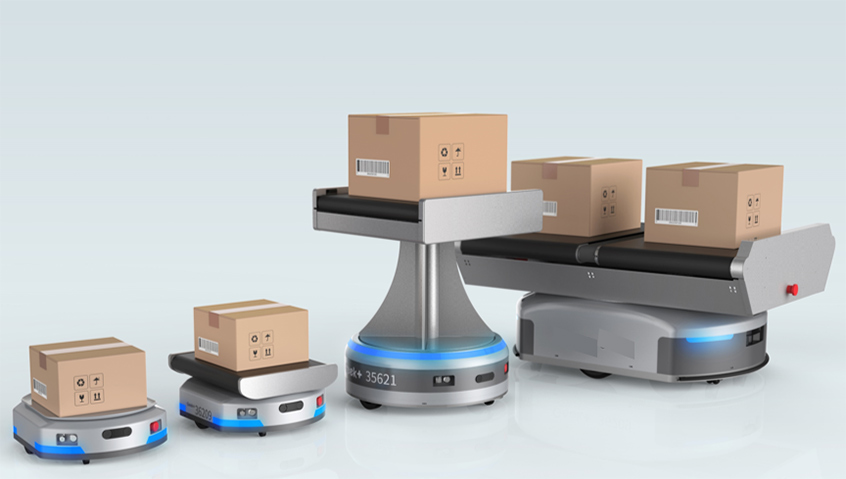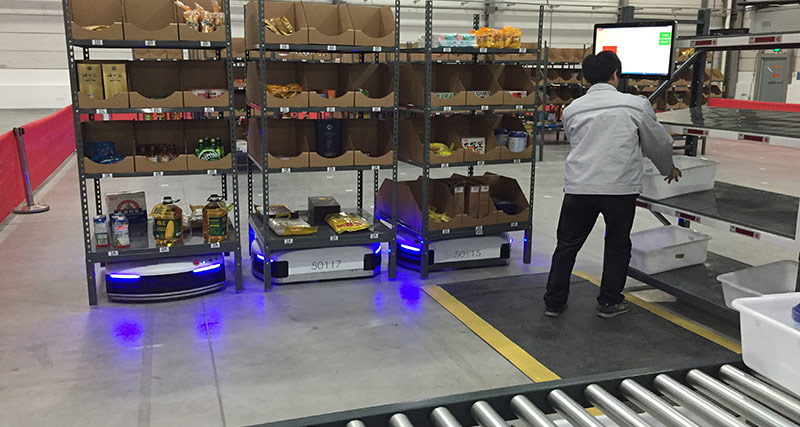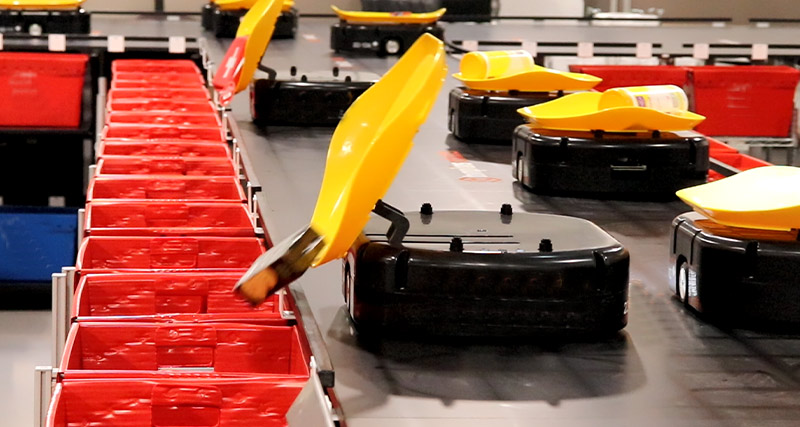Types and Applications of Autonomous Mobile Robots (AMRs)
The past few decades have brought monumental changes to the world of order fulfillment and material handling. From rising labor costs to a shrinking pool of qualified workers to increased pressure of next, same day, and two hour delivery—today’s order fulfillment operations have a lot of new challenges to conquer.
Embracing new technologies, processes, and procedures has always been an important piece of the puzzle for distribution operations, who must regularly modernize and adapt to remain competitive and profitable in this new reality. But with available technologies expanding as rapidly as they currently are, it can be difficult to know exactly which automation solutions make the most sense for your needs.
Download Our Guide To Autonomous Mobile Robots (AMRs)
The field of warehouse robotics, especially, has a lot to offer when it comes to automation technology that can be used to increase productivity and efficiency. Though certain types of warehouse robots—such as AGVs, AS/RS, and others—have already been around for years, many warehouse managers are finding themselves wondering about a new entrant to the marketplace: Autonomous Mobile Robots, also known as AMRs.
What are Autonomous Mobile Robots (AMRs)?
Broadly speaking, an autonomous mobile robot (AMR) is any robot that can understand and move through its environment without being overseen directly by an operator or on a fixed predetermined path. AMRs have an array of sophisticated sensors that enable them to understand and interpret their environment, which helps them to perform their task in the most efficient manner and path possible, navigating around fixed obstructions (building, racks, work stations, etc.) and variable obstructions (such as people, lift trucks, and debris).
Though similar in many ways to automated guided vehicles (AGVs), AMRs differ in a number of important ways. The greatest of these differences is flexibility: AGVs must follow much more rigid, preset routes than AMRs. Autonomous mobile robots find the most efficient route to achieve each task, and are designed to work collaboratively with operators such as picking and sortation operations, whereas AGVs typically do not.
In a warehouse and distribution center environment, these sophisticated technologies are integrated with the warehouse’s control systems, which allow AMRs increased flexibility to create their own routes between locations within a warehouse or facility. The end result is a robot that is much better able to work with humans within the dynamic environment offered by most order fulfillment operations.
Autonomous mobile robots make processes and workflows more efficient and productive. This is typically achieved by performing non-value added tasks—such as transporting, picking up, and dropping off product—in order to free up laborers to perform other tasks that add value to the product/operation—like picking, checking, or packing an order.
Types of Autonomous Mobile Robots

Although they are still a relatively young technology, AMRs have already branched off into a number of distinct varieties, each of which is better suited to perform a specific type of action.
For this reason, when discussions about AMRs take place, they tend to be focused on the application that the technology is meant to perform, rather than a particular name or model.
Typically, AMRs can be split into three (3) broad buckets:
- AMRs that move inventory within a facility
- AMRs that assist in the picking process
- AMRs that are a flexible sortation solution
Below, we discuss the different types of AMRs available to perform each of these actions, in order to help you better understand which type might be able to help improve your operation.
AMRs that Transport Inventory and Product
Transporting inventory and product from one place to another within a facility is, typically, a low-skill task that adds little or no value to the product or operation. As such, it is often one of the first tasks to be automated when an operation decides it is warranted. Automating product transportation means that workers can stay in their primary work area in order to perform other, more valuable tasks while work is brought to and taken away from them with AMRs.
In the past, when an operation wanted to automate the transport of product within a facility, the main options available were forklifts, conveyor and AGVs. While effective, these options are typically labor, floor space, and capital-intensive.
Today, there are a range of AMRs specifically designed to fill the efficiency gap in functionality. Instead of working with only large and heavy loads, they are designed to pick up and drop off individual cases and totes and items.
Exactly how these systems operate will depend on the exact AMR model.
AMRs That Assist in Picking
Order picking is one of the costliest tasks performed within an operation—not because it requires a high level of training or skill (it can), but because it is extremely time-consuming. In fact, physically walking from location to location within a facility can account for up to 75% of the time associated with picking.
When it comes to complementing your pick operation with AMRs, you have many different options at your disposal. The most common include:
- AMRs used in order picking
- AMRs that act as a flexible sortation solution
- AMRs that increase inventory visibility
We explore each of these options below.
1. AMRs Used In Order Picking
There are many varieties of AMRs designed specifically to reduce travel time associated with picking. This is accomplished by reducing picker travel time by bringing product to the picker. AMRs can be used to increase the productivity of picking operations in several ways.
AMRs used in conventional picking
We define conventional picking as having SKUs stored in a stationary, forward pick area in some type of shelving or rack, where pickers move from storage location to storage location picking SKUs and placing them into discrete order containers on conveyor, carts or manually carry.
In zone picking, an AMR takes an order tote/bin to a shelving or rack location within a zone. A picker, working that zone, is then able to select inventory from the surrounding locations to complete the order. Augmented vision, RF, paper pick lists or pick-to-light may be used to direct the picker. Once the order is complete the AMR will retrieve the tote and bring it to the next zone for further picking, or to a packing station for final shipping. This process is repeated with multiple AMRs operating and transporting to many zones. The end result is that a worker is able to spend more time actually picking orders, and less wasted time walking and searching.
AMRs used in Goods-to-Person Picking
Goods-to-Person picking involves storing multiple SKUs in sections of shelving, rack or bins. The AMRs are directed to retrieve a specific SKU found in the shelving. The bot maneuvers under the shelving and lifts it off the ground. The AMR then moves via the shortest path to the designated pick station.
The pick stations are designed to have a queue of AMRs with shelving on them ready to pick. The AMR moves into position and the pick-to-light directs the operator to make the correct pick and quantity. The operator is then directed to place the correct SKU and quantity into the ope orders they have in their station. As they are putting the SKU into the proper open orders, the AMR leaves and a new one presents itself. This assures that the next pick is always waiting for the operator.
The WMS/WES systems manage the entire order fulfillment process. It tracks the location and quantity of each SKU stored, in order to coordinate and optimize the AMR tasks, This eliminates wasted operator walking, searching and dwell time increasing productivity by up to 450%.
Further productivity can be gained from this type of system by setting up packing stations for specific types of orders:
- Single Line Orders: Bring case quantity of one SKU to the station and fill multiple orders at one time.
- VAS Orders: Orders that are slow to pick and/or pack that require gift cards or special handling like fragile products.
- Separate Ecommerce and Retail/Wholesale Stations: These orders have different profiles that affect productivity. Having separate stations for each type of order will produce higher overall productivity and accuracy.

Additionally, for operations that pair a pick-to-cart strategy AMRs can be incredibly useful in transporting carts from one location to another within a facility. They can, for example, move carts between zones, or bring full carts to be packed, processed, and shipped. Automating this transportation can improve total order cycle time by allowing pickers to stay in their zone, reducing travel time and increasing efficiency.
AMRs That Facilitate Picking in Other Ways
In addition to the varieties discussed above, there are other ways that AMRs can be used to facilitate the picking process.
For example, they can be used for realtime SKU replenishment. AMRs can be used to not only carry replenishment containers to the forward pick area, but also put the containers away automatically in rack, shelving, or carton flow rack. The host system knows when a SKU storage location is running low and can generate and deliver the required replenishment inventory.
In a fulfillment operation that uses conveyor to transport order containers through picking, packing, and shipping, there can still be product or orders that are not suited to the conveyor system. The product can be fragile or the container too large to go on the conveyor system, or the operation may have 80% of the picking locations serviced by the conveyor system and 20% (slowest moving SKUs) stored and picked in an offline area. In these situations, AMRs can be used like flexible conveyor to transport the orders through picking and then delivered the completed orders directly to a specified packing or shipping station or area. If there are case pick orders where split case orders are fulfilled, AMRs can be used to handle pallets or cartons and eliminate the related travel labor.
2. AMRs for Flexible Sortation
Autonomous mobile robots can also play an important role in sortation. Different models come equipped with a variety of handling technologies. From conveyor roller to tilt trays and cross belt systems, AMRs are equipped for a wide range of sortation solutions including:
- High-speed parcel sortation
- Ecommerce order fulfillment
- Returns handling
- Short-term sortation

High-speed AMR sortation is easily achieved by utilizing a fleet of TiltSort-Bot tilt tray AMR models. These bots work on a mezzanine with chutes for location or order positions. Either people or robotic arms induct an item on the top of the TiltSort-Bot. The induction station camera above the bot reads the barcode and takes off via the shortest path to its destination chute. Once it comes upon its chute position, it stops parallel to it and tilts the item off the bot and down the chute. Items or parcels are collected in sacks, gaylords or containers. Once complete either an operator or AMR takes the completed order to shipping. Another AMR brings in an empty container to resume the sortation process.

Floor sortation for ecommerce, returns, kitting, and order fulfillment can be accomplished by using a HighTilt-Bot sorter AMR. These units are 42” tall and are equipped with a tilt tray top. This system works directly on the floor and can be expanded or condensed based on daily requirements.
In the illustration above, you have induction stations on the sides. Items or parcels are delivered to each station. The operator simply places the item, barcode up, on the bot. The camera above reads the barcode and the AMR moves via the shortest path to its order destination. The destination can be a gaylord, tote or pallet position. The AMR stops when it is parallel to the position and tilts the item into the storage location. When the position is full or complete a transfer AMR comes and moves it to the pack stations located in the front of zone. Another transfer AMR delivers an empty gaylord, bin, or pallet to the open position to resume that position.

Consolidation and returns sortation using put workstations. In this application, AMRs bring to a workstation an open gaylord, bin or pallet. They queue in position. As one is complete and leaves another AMR moves into position. The operator is directed to put the correct item and quantity in the bin. This process is repeated until complete.
The AMR will then take the completed order to buffer storage, shipping or a pick location for order fulfillment. There is tremendous flexibility in designing and implementing this application. This application eliminates operators wasted walk and search time and is tremendously flexible to varying business requirements.
These robots utilize a wide variety of technologies to induct and discharge inventory. Common induction methods include: Robotic arms, manual placement, conveyor, shelving and more. Likewise, AMRs can discharge to chutes, shelving, flow rack, conveyor, workstations and much more.
This allows AMRs to receive product, sort it, and transport to where it needs to be. These AMRs can be used for conveyor-to-conveyor transportation, bridging gaps and extending existing conveyance.
Because AMRs are nonlinear, they can be used for sequencing product in picking and shipping operations. Product may come out of picking in a certain order that is not ideal for palletizing an order. AMRs can take product in any order and deliver it to a palletizing station so that the heaviest product is on the bottom and fragile or lightest product is on the top.
This same method can be applied to floor-loaded trailers that are unloaded in reverse stop sequence. AMRs can be used to sort the order containers so the last stop is loaded first and the first stop is loaded last.

AMRs that Increase Inventory Visibility
Accurate, clear inventory visibility—knowing where product is within your distribution center, warehouse, and overall supply chain—is critical to modern order fulfillment. But for particularly large and complex operations, inventory movement and reconciliation can be a daunting and time-consuming process to coordinate. A fleet of AMRs, directly integrated with the system, allows for automation which drastically reduces the amount of time and cost required to keep productivity and order accuracy maximized.
No inventory system is perfect, because events happen that do not record the right amount of product received, put away, replenished, or picked. The system directs each of these tasks and has checking processes built in to catch inventory irregularities and anomalies. It also manages cycle counting to catch irregularities before they become an operational problem.
The Bottom Line
Whether or not autonomous mobile robots (AMRs) or another type of automation makes sense for your order fulfillment operation will depend largely on the specifics of your business. A skilled and trusted systems integrator can help you to determine the best path forward for your business. They have the skill and experience to help you analyze your operation and make recommendations that are the right fit for your business and operation.
Unlike most conventional material handling equipment and systems, AMRs lend themselves to Proof of Concept (POC) systems. The modularity, scalability, and flexibility of AMRs allow POC systems to be designed and implemented cost-effectively. After the POC is complete, virtually the entire system is able to be moved and integrated into the full system. Saving time and resources while reducing risk. Call or email a Conveyco consultant for understanding this process.





